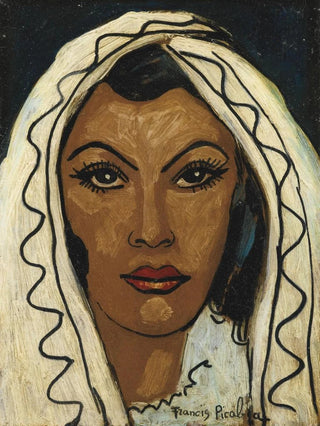Art print | Untitled - Francis Picabia


View from behind

Frame (optional)
In the vast panorama of modern art, the piece "Untitled" by Francis Picabia stands out for its boldness and its ability to challenge established conventions. Picabia, an iconic figure of the Dada movement, captured the essence of a rapidly changing era, where certainties waver in favor of limitless exploration. This artwork, both intriguing and disorienting, invites viewers to immerse themselves in a universe where meaning slips away and emotion takes precedence over reason. The art print of "Untitled - Francis Picabia" thus allows for a rediscovery of this masterpiece, while offering a glimpse into the richness and complexity of 20th-century art.
Style and uniqueness of the work
The piece "Untitled" is characterized by a radical approach that transcends traditional forms. Lines, colors, and textures intertwine in a chaotic dance, creating a captivating visual dialogue. Picabia plays with contrasts, between abstraction and figuration, between movement and stillness. This duality manifests in the use of repetitive motifs and organic shapes that seem both familiar and strange. Viewers are thus confronted with a unique sensory experience, where each glance reveals a new facet of the artwork. The singularity of "Untitled" also lies in its ability to evoke varied interpretations, inviting each person to project their own emotions and reflections onto this enigmatic canvas.
The artist and his influence
Francis Picabia, born in 1879 in Paris, was a multifaceted artist whose career was marked by decisive encounters and diverse artistic movements. A convinced Dadaist, he challenged the foundations of art and society through provocative works. His influence extends beyond his era, inspiring many contemporary artists seeking to explore the boundaries of creativity. Picabia established a link between the world of machines and art, incorporating elements of popular culture and references to emerging technology. This innovative approach allowed him to create a unique visual language that continues to resonate in the current art scene.

Matte finish

View from behind

Frame (optional)
In the vast panorama of modern art, the piece "Untitled" by Francis Picabia stands out for its boldness and its ability to challenge established conventions. Picabia, an iconic figure of the Dada movement, captured the essence of a rapidly changing era, where certainties waver in favor of limitless exploration. This artwork, both intriguing and disorienting, invites viewers to immerse themselves in a universe where meaning slips away and emotion takes precedence over reason. The art print of "Untitled - Francis Picabia" thus allows for a rediscovery of this masterpiece, while offering a glimpse into the richness and complexity of 20th-century art.
Style and uniqueness of the work
The piece "Untitled" is characterized by a radical approach that transcends traditional forms. Lines, colors, and textures intertwine in a chaotic dance, creating a captivating visual dialogue. Picabia plays with contrasts, between abstraction and figuration, between movement and stillness. This duality manifests in the use of repetitive motifs and organic shapes that seem both familiar and strange. Viewers are thus confronted with a unique sensory experience, where each glance reveals a new facet of the artwork. The singularity of "Untitled" also lies in its ability to evoke varied interpretations, inviting each person to project their own emotions and reflections onto this enigmatic canvas.
The artist and his influence
Francis Picabia, born in 1879 in Paris, was a multifaceted artist whose career was marked by decisive encounters and diverse artistic movements. A convinced Dadaist, he challenged the foundations of art and society through provocative works. His influence extends beyond his era, inspiring many contemporary artists seeking to explore the boundaries of creativity. Picabia established a link between the world of machines and art, incorporating elements of popular culture and references to emerging technology. This innovative approach allowed him to create a unique visual language that continues to resonate in the current art scene.






